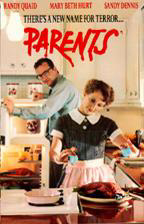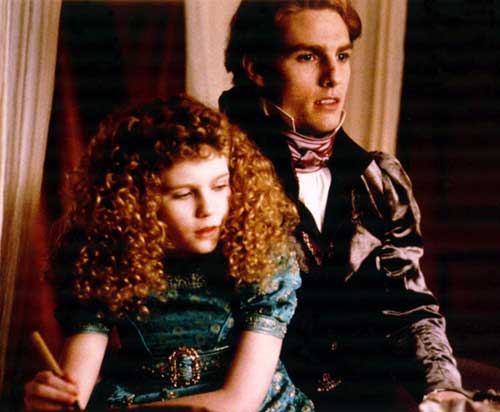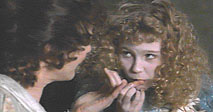


"Film
Fatales."...
3BACK
| HOME | NEXT4
______________________________________________________________
If the 1950's have come to represent man's desire to tame nature, domesticate
women, and sterilize living environments (with inventions ranging from
pesticides to household appliances), then Mary Beth Hurt, as Lily Laemle,
is the perfect satirical cannibal in the 1989 movie Parents: a
black comedy in which a boy's parents kill and cannibalize people in their
community, behind a façade of 1950's smiles. Even though both parents
are co-conspirators in the killings, it is the mother who cooks and serves
the delicacies, with all the flair of a perfect housewife. The son, who
is actually the main character, only subconsciously understands what is
happening as he is plagued by vivid dreams of blood, as if the act of
ingestion transforms the human flesh into subconscious awareness. This
awareness becomes a commentary on the American family and the marketing
machinery that sells images of it.
In some ways,
Lily is Hannibal Lecter's female counterpart, showing us a sterilized/cooked
culture. While the flawlessly polite Hannibal is all but hermetically
sealed in a glass cell and fantasizes about human organs, cheerful Lily
appears sealed in her 1950's home cooking up something that looks like
meatloaf. While Hannibal is showcased as an aberrant beast, however, Lily
is putting on a show as the perfect mother and wife, clearly satirizing
traditional roles of both, and pointing to the secret discontent they
can breed. Visceral desire, strikingly out of place in this setting, manifests
in the consumption of flesh, which is relished as natural, pleasurable,
and wholesome. Overall, the humor and satirical distance in the movie
allow us to see the mother character as a social commentator, rather than
merely a spectacle of gore.
Anne Rice's work, in contrast to Parents, depicts dysfunctional
family structure in a cannibalistic environment that is anything but sanitized
or cooked. In the 1994 movie Interview With the Vampire (based
on Rice's novel by the same title, 1976), vampire characters are doomed
by virtue of the patriarchal order that Lestat (played by Tom Cruise)
represents as their original "maker" and ruler of the household.
In this environment, the child vampire Claudia becomes a reminder of normal
developmental needs that cannot be met, and emotional desires that cannot
be experienced in a healthy way. She is the insatiable child who can never
grow up or change and has an endless appetite for attention and food (in
this case the human blood that she suckles on as readily as a baby would
suckle a mother's breast). As in the movie Parents, the relationship
dynamics in Interview with the Vampire remind us of the workings of dysfunctional
families, but this time the female figures represent both the internalization
of and rebellion against patriarchal order, with Lestat as the controlling
father; Claudia as the delinquent daughter (emotionally stunted, deceptive
and needy); and Louis as the nurturer who attempts to fulfill all roles
for her (as brother, father, mother, lover). "Normal" relationships
lie outside the boundaries of the vampire world, as death and desire become
one. So Louis' desire to be a father and Claudia's desire to have a mother
require blood sacrifice and are never fully successful. Meanwhile, the
crossing of role boundaries, and the parallel crossing of flesh boundaries,
are on one hand necessary for vampire survival and on the other hand impossible
to live with. In this case, the patriarchal order can never completely
be transcended (it is written in blood, in the physical body), and to
challenge it is to challenge one's own flesh, or even to starve. Yet,
Claudia does challenge and transcends Lastadt's order, first by seducing
him to feed on a corpse (an apparently fatal violation of "normal"
vampire biology) and then by "making" her own "mother,"
bringing home and sucking the blood of a willing victim who has lost her
own child and longs to be Claudia's mother. In this act, Claudia becomes
creator and innovator, meeting her own needs with an emotional alliance
that she forges in blood, yet consummates in emotional bonding.
Obese characters add physical weight to cannibalistic themes, both supporting and breaking with traditions of woman as destructive devourer. In the 1993 movie What's Eating Gilbert Grape? the answer is: everyone in Gilbert's family, but especially his obese mother and the guilt she instills in him about taking care of his family when she cannot.
CONTINUE 4